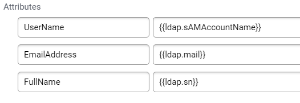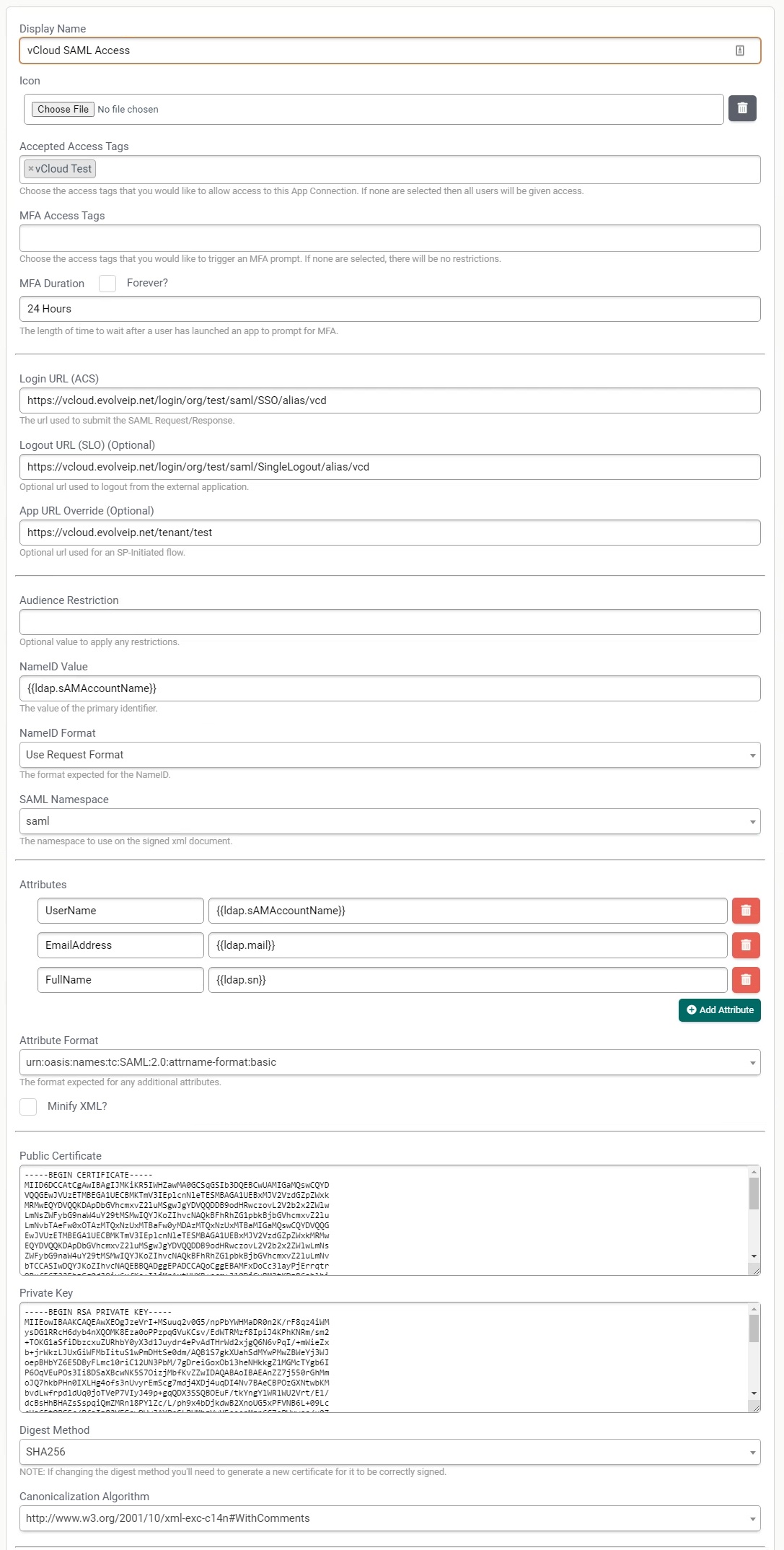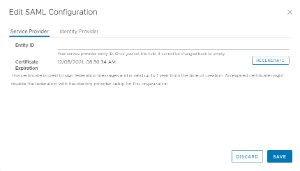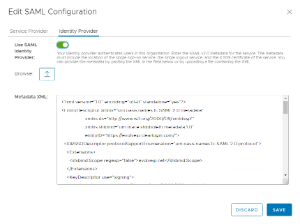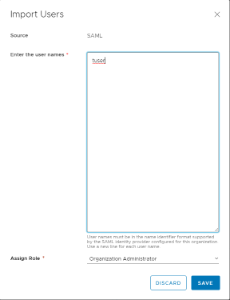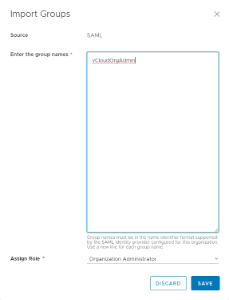You can configure your Organization to utilize a SAML Identity Provider for quick and secure access. In this documentation we will show how to configure with EvolveIP's Identity and Access Management. Other vendors can be configured with the same general settings, however their support team might need involved if there are issues during the setup.
Configuring SAML is comprised of these steps:
- Configure your Service Provider (in this case, EvolveIP's Identity and Access Management / ClearLogin) for your vCloud Organization.
- Configure your vCloud Organization with the configuration metadata XML from your service provider.
- Configure your vCloud Organization with the user accounts to allow access.
- Bypass SAML if there is an issue.
When an imported user attempts to log in, the system extracts the following attributes from the SAML token, if available, and uses them for interpreting the corresponding pieces of information about the user:
- email address = "EmailAddress"
- user name = "UserName"
- user's groups = "Groups"
- user's roles = "Roles" (this attribute is configurable)
Group information is used if the user is not directly imported but is expected to log in by being a member of an imported group. A user can belong to multiple groups, so can have multiple roles during a session.
If an imported user or group is assigned the Defer to Identity Provider role, the roles are assigned based on the information gathered from the Roles attribute in the token. If a different attribute is used, this attribute name can be configured using API and only the Roles attribute is configurable. If the Defer to Identity Provider role is used, but no role information can be extracted, the user can log in but has no rights to perform any activities. With that information, we typically recommend against importing users or groups using the Defer to Identity Provider role.
Local User Account
You should keep an enabled local Org Admin account in case you need to bypass SAML.
If you subscribe to Self-Service BaaS, SAML credentials cannot be used to log into your Self-Service portal. You will NEED to use a local (non-SAML) Org Admin account when logging into your BaaS Self-Service portal.
Prerequisites
This operation requires the rights included in the predefined Organization Administrator role or an equivalent set of rights.
This operation requires you have administrative rights to create SAML applications within your Identity Provider.
Procedure
Configure your Identity Provider
- Navigate within your Identity Provider (IDP) to create a new SAML App.
- Display Name: Provide a display name
- Login URL (ACS): This is the login URL for your vCloud Director tenant. This can be found by downloading the XML info from your vCloud Organization.
- On the Virtual Datacenters dashboard screen, click the card of the virtual data center you want to explore.
- From the main menu select Administration.
- In the right panel under Identity Providers, click SAML.
- Click on the Metadata link and download the .xml
- The Login URL will be towards the bottom under the section "<md:AssertionConsumerService Location" and will be in this format:
- https:// (vCloud URL) /login/org/ (Organization Name) /saml/SSO/alias/vcd
- For example, if your vCloud URL is https://vcloud.evolveip.net and your Organization Name is "Test" the Login URL would be:
- https://vcloud.evolveip.net/login/org/test/saml/SSO/alias/vcd
- The Login URL will be towards the bottom under the section "<md:AssertionConsumerService Location" and will be in this format:
- Click on the Metadata link and download the .xml
- Logout URL (ACS): This is the logout URL for your vCloud Director tenant. This can be found by downloading the XML info from your vCloud Organization.
- On the Virtual Datacenters dashboard screen, click the card of the virtual data center you want to explore.
- From the main menu select Administration.
- In the right panel under Identity Providers, click SAML.
- Click on the Metadata link and download the .xml
- The Logout URL will be towards the bottom under the section "<md:SingleLogoutService Location" and will be in this format:
- https:// (vCloud URL) /login/org/ (Organization Name) /saml/SingleLogout/alias/vcd
- For example, if your vCloud URL is https://vcloud.evolveip.net and your Organization Name is "Test" the Login URL would be:
- https://vcloud.evolveip.net/login/org/test/saml/SingleLogout/alias/vcd
- The Logout URL will be towards the bottom under the section "<md:SingleLogoutService Location" and will be in this format:
- Click on the Metadata link and download the .xml
- App URL Override: This is the tenant URL you would use to log into vCloud Director.
- For example, if your vCloud URL is https://vcloud.evolveip.net and your Organization Name is "Test" the Login URL would be:
- https://vcloud.evolveip.net/tenant/test
- For example, if your vCloud URL is https://vcloud.evolveip.net and your Organization Name is "Test" the Login URL would be:
- NameID Value: This is the main username attribute that will be sent. This attribute is what vCloud will validate against when signing in. We typically recommend using as the value.
- Attributes: These are the attributes that will populate the imported user account upon first sign in.
- Attribute Format: Use the following: urn:oasis:names:tc:SAML:2.0:attrname-format:basic
- Digest Method: SHA256
- The configured system should look like this:
- Export the SAML XML configuration for import into vCloud.
Configure your vCloud Organization (Service Provider)
- On the Virtual Datacenters dashboard screen, click the card of the virtual data center you want to explore.
- From the main menu select Administration.
- In the right panel under Identity Providers, click SAML.
- In the left pane click Edit.
- Service Provider
- Entity ID: This field does not require any data, and is not utilized with EvolveIP's Identity and Access Management system. If something is entered here, it cannot be changed back to empty.
- Certificate Expiration: The Service Provider certificate expires after 1 year. You will need to navigate to this location and click Regenerate to prevent the certificate from expiring. We recommend clicking Regenerate when configuring SAML to reset the expiration timer.
- If you configured notifications for your Organization you will be notified when the certificate is about to expire.
- Identity Provider
- User SAML Identity Provider: Enable the slider button to enable SAML authentication for your Organization.
- Metadata XML: Copy or upload your metadata XML from your Service Provider
- Click Save to complete this step of the process.
Import Users or Groups for SAML Authentication
- On the Virtual Datacenters dashboard screen, click the card of the virtual data center you want to explore.
- From the main menu select Administration.
- Users: Import individual users for SAML access.
- On the left pane under Access Control and click Users.
- Click Import Users. (This option is only available if SAML is enabled as outlined above.)
- Enter the user names one per line in the Import Users window.
- User names must be in the format configured in the IDP setup, in this example we specified sAMAccountName in the IDP configuration.
- Click the drop-down and assign a role for the users.
- The role will be assigned to all users. If you want to import multiple users with different roles they need to be imported in batches based on their group access.
- Enter the user names one per line in the Import Users window.
- Click Save to complete the process of importing users for SAML authentication.
- Groups: Specify which groups should be allowed to log in via SAML. Users will be created as they successfully log into the system.
- On the left pane under Access Control click Groups.
- Click Import Groups. (This option is only available if SAML is enabled as outlined above.)
- Enter the group names one per line in the Import Groups window.
- The group names must match the format configured in the IDP setup.
- Enter the group names one per line in the Import Groups window.
- Click Save to complete the process of importing groups for SAML authentication.
You should now be able to authenticate utilizing your SAML IDP into vCloud. If you run into any issues please contact EvolveIP Support.
Bypass SAML
In the event that there is an issue with either the IDP or Service Provider preventing sign in via SAML authentication, you can bypass SAML authentication.
To do this, manually enter the tenant URL of your vCloud Organization adding "/login" to the end of the URL.
For example, if your vCloud URL is https://vcloud.evolveip.net and your Organization Name is "Test".
The URL used to bypass SAML would be https://vcloud.evolveip.net/tenant/test/login
You will then be presented with the local username and password prompt. You will need to provide local credentials in order to access the system.

